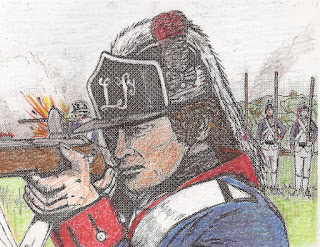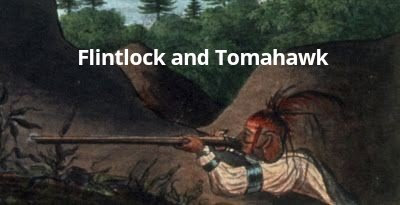Sunday, 30 July 2017
Thursday, 27 July 2017
Wednesday, 26 July 2017
French and Indian War paper soldiers
I like paper soldiers. I don't cut them up but I do like to look at them - and here's a site with a nice range of F&I War ones that you might like - here
Tuesday, 25 July 2017
Sunday, 23 July 2017
Wednesday, 19 July 2017
Ticonderoga this weekend
This Saturday, July 22nd at 11:00AM, discover the form and function of
the French fusil. Watch as a Piquet of French soldiers drill to
coordinate their firepower together for potentially devastating effects. For more information about our Montcalm’s Cross Reenactment visit http://www.fortticonderoga.org/…/montcalm-s-cross-th…/detail
Monday, 17 July 2017
Drawings by Ralph Mitchard
More of my artwork can be seen here
 |
| Milicien and Native SYW |
 |
| Log fort |
 |
| SYW Native |
 |
| Light Infantry Revwar |
 |
| Revwar Saratoga British |
 |
| Native warrior 1755 |
Tuesday, 11 July 2017
Sunday, 9 July 2017
1676 - King Philip's War Skirmish rules
Here to download these
Pilgrim cavalry charges! Desperate attacks on fortified settlements! Daring ambushes! These are just a few of the skirmishes you can fight with 1676 - a tabletop miniatures game set in New England during the Native American uprising that became known as King Philip’s War.
The types of conflicts that occurred in King Philip’s War were usually small skirmishes that can be represented on a tabletop with these rules. You can play a native war party or a force from the Army of the United Colonies. If you want to add “fell creatures,” magic, & (gasp!) European powers, there is a supplement available with these additions (Mad Dogs & Englishmen).
The core rules are provided in only 5 pages. They are simple & straightforward. Simple die rolls - using 6- & 8-sided dice - are used to resolve combat & other actions. Most actions have the same target for success, so they are resolved quickly.
You can use one of the pre-made “armies” provided in a second PDF (Part Two), or can create your own balanced forces using a simple point build system. Part Two includes unit cards, sample army lists, & all the tokens you’ll need. Alternatively, premade Unit cards, Command cards, & (Mis)Fortune cards are now available from The Game Crafter.
Both books are illustrated with photographs of figures from Brigade Games' King Philip's War line. With these figures (supplemented by those from other manufacturers), you can now easily field beautiful forces in miniature to represent the combatants.
So heed the call to arms! Your colony or tribe is depending on you!
Pilgrim cavalry charges! Desperate attacks on fortified settlements! Daring ambushes! These are just a few of the skirmishes you can fight with 1676 - a tabletop miniatures game set in New England during the Native American uprising that became known as King Philip’s War.
The types of conflicts that occurred in King Philip’s War were usually small skirmishes that can be represented on a tabletop with these rules. You can play a native war party or a force from the Army of the United Colonies. If you want to add “fell creatures,” magic, & (gasp!) European powers, there is a supplement available with these additions (Mad Dogs & Englishmen).
The core rules are provided in only 5 pages. They are simple & straightforward. Simple die rolls - using 6- & 8-sided dice - are used to resolve combat & other actions. Most actions have the same target for success, so they are resolved quickly.
You can use one of the pre-made “armies” provided in a second PDF (Part Two), or can create your own balanced forces using a simple point build system. Part Two includes unit cards, sample army lists, & all the tokens you’ll need. Alternatively, premade Unit cards, Command cards, & (Mis)Fortune cards are now available from The Game Crafter.
Both books are illustrated with photographs of figures from Brigade Games' King Philip's War line. With these figures (supplemented by those from other manufacturers), you can now easily field beautiful forces in miniature to represent the combatants.
So heed the call to arms! Your colony or tribe is depending on you!
Hodges' Scout
I havent read this but the consensus on my Seven Years War Living History FB page was that it was a good book. I must admit to thinking it was fiction when I saw it before!
In September 1756, fifty American soldiers set off on a routine reconnaissance near Lake George, determined to safeguard the upper reaches of the New York colony. Caught in a devastating ambush by French and native warriors, only a handful of colonials made it back alive. Toward the end of the French and Indian War, another group of survivors, long feared dead, returned home, having endured years of grim captivity among the native and French inhabitants of Canada.
Pieced together from archival records, period correspondence, and official reports, Hodges' Scout relates the riveting tale of young colonists who were tragically caught up in a war they barely understood. Len Travers brings history to life by describing the variety of motives that led men to enlist in the campaign and the methods and means they used to do battle. He also reveals what the soldiers wore, the illnesses they experienced, the terror and confusion of combat, and the bitter hardships of captivity in alien lands. His remarkable research brings human experiences alive, giving us a rare, full-color view of the French and Indian War--the first true world war.
In September 1756, fifty American soldiers set off on a routine reconnaissance near Lake George, determined to safeguard the upper reaches of the New York colony. Caught in a devastating ambush by French and native warriors, only a handful of colonials made it back alive. Toward the end of the French and Indian War, another group of survivors, long feared dead, returned home, having endured years of grim captivity among the native and French inhabitants of Canada.
Pieced together from archival records, period correspondence, and official reports, Hodges' Scout relates the riveting tale of young colonists who were tragically caught up in a war they barely understood. Len Travers brings history to life by describing the variety of motives that led men to enlist in the campaign and the methods and means they used to do battle. He also reveals what the soldiers wore, the illnesses they experienced, the terror and confusion of combat, and the bitter hardships of captivity in alien lands. His remarkable research brings human experiences alive, giving us a rare, full-color view of the French and Indian War--the first true world war.
Braddock's defeat 1755
 |
| James Mason as Braddock in the Washington miniseries |
Saturday, 8 July 2017
Thursday, 6 July 2017
July 22 Fort Ticonderoga Recreates Epic 1758 Battle of Carillon
Details
Join
Fort Ticonderoga July 22-23, 2017 for an exciting battle re-enactment
highlighting the epic 1758 Battle of Carillon! Witness how the British
amassed the largest army in North American history to date, yet was
stunningly defeated by a French army a quarter of its size. Highlighted
programming featured throughout the weekend brings to life the story of
the courageous French soldiers that protected their lines of defense
against all odds. Visitors will meet the British and Provincial soldiers
who gave their utmost to drive the French from the rocky peninsula and
fortress of Carillon, later named Ticonderoga. Experience the fog of war
and smoky haze of battle as the French and British armies maneuver
across Fort Ticonderoga’s historic landscape in battle re-enactments
each day.
For more information and to view a detailed visitor's schedule, visit http://
For more information and to view a detailed visitor's schedule, visit http://
Monday, 3 July 2017
Saturday, 1 July 2017
Nipissing Indian in Canada, 1717
From here This hand-colored print dating from 1717 shows a
Nipissing warrior, armed with bow and arrows, wearing moccasins,
clothed in a tunic and cape obtained from the Europeans, and covered in
tattoos. The French in Canada, priests in particular, found native
tattoos repellent for religious reasons having to do with the sanctity
of the human body. The Nipissing are an Algonquin people, first
encountered by the French in 1613. Beginning in the early 1600s, the
French formed alliances and developed friendships with a number of
Indian tribes, including the Montagnais, Algonquin, Etchimin, and Micmac
peoples. Their most important allies were the Huron. Following the
defeat in 1648–50 of the Huron confederation by the Iroquois, the French
worked to consolidate a vast native league that brought together the
Nipissing, the Ottawa, Ojibwa (Chippewa), Potowatomi, Mascouten, Fox,
Kickapoo, Winnebago, Sauk, Miami, and Illinois tribes. This major
diplomatic effort culminated in the Great Peace of Montreal of 1701
between France and between 30 and 40 Indian tribes (referred to in
Canada as First Nations).
Subscribe to:
Comments (Atom)
Iroquois warrior
Artist unknown, Homme Iroquois, late 18th century, Musée National des Beaux-Arts du Québec.

-
Our colonial Marine unit gets some last minute instruction before going to fight the British. Pinterest for more.
-
This is the first stage of an excellent project. This is the corner tower of a recreation of the fort in the movie Drums Along the Mohawk...





























